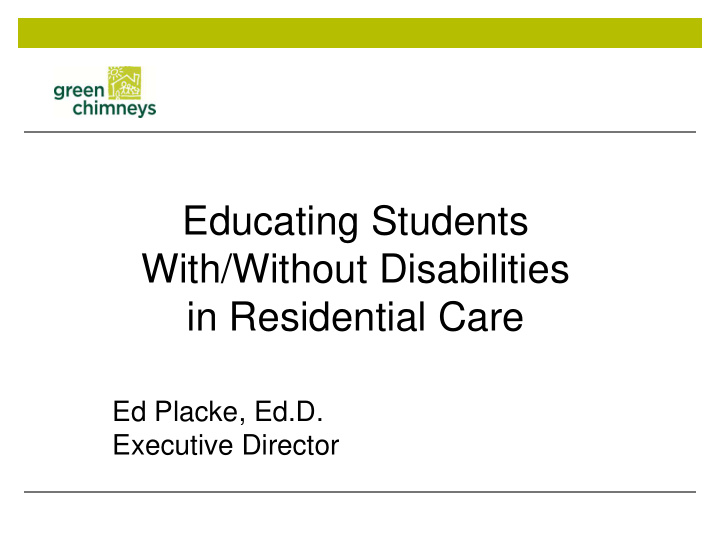



Educating Students With/Without Disabilities in Residential Care Ed Placke, Ed.D. Executive Director
Academic Characteristics of Students in Residential Care Older School-aged Males Average to Low Average IQs (Limited Executive Functioning) Chronic Health Concerns On Prescribed Medications Difficulties with Peer Relations Severe Emotional and Behavioral Issues Minimal High School Credits Reading, Writing, Listening and Math Skills Below Expectations Leloux-Opmeer (2016). Charcteristics . . . . . . . . . . . Springerlink.com, 25, 2357-2371 2 Gaskins, C. (2009). Academic and Behavioral . . . . . Retrieved from ERIC. (ERIC No. ED 531207 )
How do we prepare students academically to return to less restrictive environments such as community high schools, BOCES programs or 853 schools as a day student? 3
Literacy, executive functioning skills and principles of instruction are several of the key components to preparing students to successfully transition from a residential school 4
Possible Solutions Integrate literacy skills into all academic lesson plans 7 Keys to Literacy 5
TEACHER’S PLANNING CHECKLIST FOR THE SEVEN CREATE MENTAL IMAGES USE BACKGROUND KNOWLEDGE ASK QUESTIONS MAKE INFERENCES DETERMINE THE MOST IMPORTANT IDEAS OR THEMES SYNTHESIZE INFORMATION USE “FIX UP” STRATEGIES 6
GOOD READERS USE THE FOLLOWING SEVEN KEYS TO UNLOCK MEANING: CREATE MENTAL IMAGES: Good readers create a wide range of visual, auditory, and other sensory images as they read, and they become emotionally involved with what they read. USE BACKGROUND KNOWLEDGE: Good readers use their relevant prior knowledge before, during, and after reading to enhance their understanding of what they’ re reading. ASK QUESTIONS: Good readers generate questions before, during, and after reading to clarify meaning, make predictions, and focus their attention on what’s important. MAKE INFERENCES: Good readers use their prior knowledge and information from what they read to make predictions, seek answers to questions, draw conclusions, and create interpretations that deepen their understanding of the text. DETERMINE THE MOST IMPORTANT IDEAS OR THEMES: Good readers identify key ideas or themes as they read, and they can distinguish between important and unimportant information. SYNTHESIZE INFORMATION: Good readers track their thinking as it evolves during reading, to get the overall meaning. USE “FIX UP” STRATEGIES: Good readers are aware of when they understand and when they don’t. If they have trouble understanding specific words, phrases or longer passages, they use a wide range of problem-solving strategies including skipping ahead, rereading, asking questions, using a dictionary, and reading the passage aloud. 7
Teach Executive Functioning Skills “Executive functioning is the mental process that enables us to plan, focus attention, remember instructions and juggle tasks successfully . . . the brain needs this skill set to filter distractions, prioritize tasks, set and achieve goals and control impulses.” 8
Executive Function Skills and Examples Memorization – acronyms/visuals/repetition Cognitive Methodology – Problem solving options Prioritizing – High light/bold font/end of chapter questions Notetaking – Column note format, i.e., Cornell Note Taking System Self-Regulation – Checklists for assignments/self-talk 9
Principles of Instruction Implement all lesson plans via the principles of instruction (Evidence-based) which are teaching functions abstracted from research proved effective in improving student learning Rosenshine. B. (2012 ). Principles of Instruction: Research-Based Strategies That All Teachers Should Know . American Edition (12-39) 10
Principles of Instruction Begin a lesson with a short review of previous learning. Present new material in small steps with student practice after each step. Ask a large number of questions and check the responses of all students. Provide models. Guide student practice. Check for student understanding. Obtain a high success rate. Provide scaffolds for difficult tasks. Require and monitor independent practice. Engage students in weekly and monthly review. 11
Questions & Answers 12
Recommend
More recommend